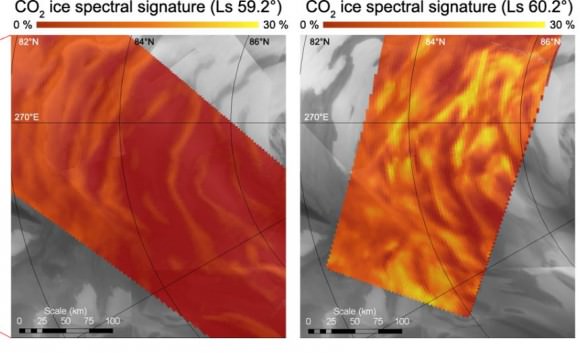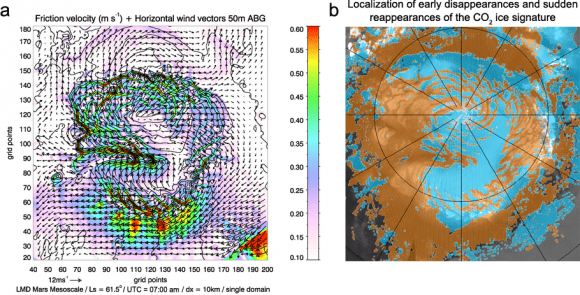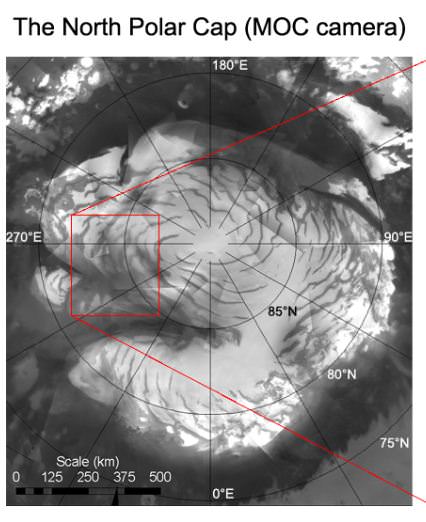[/caption]
Mars has permanent ice caps at both poles composed mostly of solid carbon dioxide, and mysteriously, a large portion of the northern cap disappears early in the northern Martian spring followed later by its sudden reappearance. Scientists may have solved this mystery, saying that strong winds and Mars’ active water cycle may play a part in ‘come and go’ polar cap.
Earlier this year, another group of scientists from the University of Texas found that so-called katabatic winds — a wind that carries high density air from a higher elevation down a slope under the force of gravity – were responsible for the formation of giant swirls or troughs in the northern polar cap, as well as a huge chasm that is also visible. Those winds may also play a part in the regeneration of the ice cap.
Seasonal ice deposits play a major role in the water cycle of the planet. Every Martian year, alternatively during northern and southern winter, a significant part of the atmosphere condenses on the surface in the form of frost and snow. These seasonal ice deposits, which can be up to one meter thick, are mainly composed of carbon dioxide with minor amounts of water and dust. During spring, the deposits sublimate becoming a substantial source of water vapor, in particular in the northern hemisphere of the planet.

Dr. Bernard Schmitt and Mr. Thomas Appéré analyzed data taken with the OMEGA instrument on board ESA’s Mars Express, honing in on two northern Martian regions. Before the Mars Express mission, scientists monitored the evolution of the seasonal deposits by looking at the albedo (reflectivity) and temperature changes of the surface, as the ice deposits appear much brighter and are colder than the surrounding defrosted terrains.
The first Martian region that the scientists observed is located on Gemina Lingula, a Northern plateau, where a peculiar evolution of the carbon dioxide ice deposits was observed.
“During spring the ice signature disappeared from our data, but the surface temperature was still cold enough to sustain plenty of CO2 ice,” said Schmitt. “We concluded that a thick layer of something else, either dust or water ice was overlaid. If it was dust then it would also hide water ice and the surface of the planet would become darker. None of these happened so we concluded that a layer of water ice was hiding the CO2 ice. We had to wait until the weather gets warm enough on Mars for the water to vaporize as well, and then the carbon dioxide signatures re-appeared in our data.”
Soon after spring sunrise, the solar radiation hitting the surface of Mars warms enough the CO2 ice lying on the top layer to cause it to vaporize. But the water ice needs higher temperatures to sublimate, so a fine grained layer of water ice gradually forms hiding the carbon dioxide ice still lying beneath it.
“A layer only 2 tenths of a millimeter thick is enough to completely hide the CO2 ice. Also some water that has been vaporized at lower, warmer, Martian latitudes condenses as it moves northward and may be cold trapped on top of the CO2 ice,” said Appéré.
The second region analyzed by the team is located in the spiral troughs structure of the North permanent cap. A similar situation was observed but the carbon dioxide ice re-appeared very quickly here after its initial disappearance.
“This hide-and-seek game didn’t make much sense to us. It wasn’t cold enough for CO2 ice to condense again, neither warm enough for water ice to sublimate,” said Schmitt.

“We concluded that somehow the water ice layer was removed,” said Appéré. “The topography of the North permanent Martian cap is well-suited to entail the formation of strong katabatic winds.”
Another scientist, Dr. Aymeric Spiga, used a model to simulate those winds and he indeed confirmed the sudden re-appearances of CO2 ice where strong katabatic winds blow.
This is just the first step in figuring out exactly how the polar cap disappears and reappears on Mars.
“To decipher the present and past water cycles on Mars and improve our weather models on the planet, one needs to have a good understanding of the seasonal ice deposits dynamics, how they change in space and time,” said Schmitt. “We are confident that our results will make a significant contribution in this direction.”


So Mars’ ice cap is sort of like a frozen hurricane?